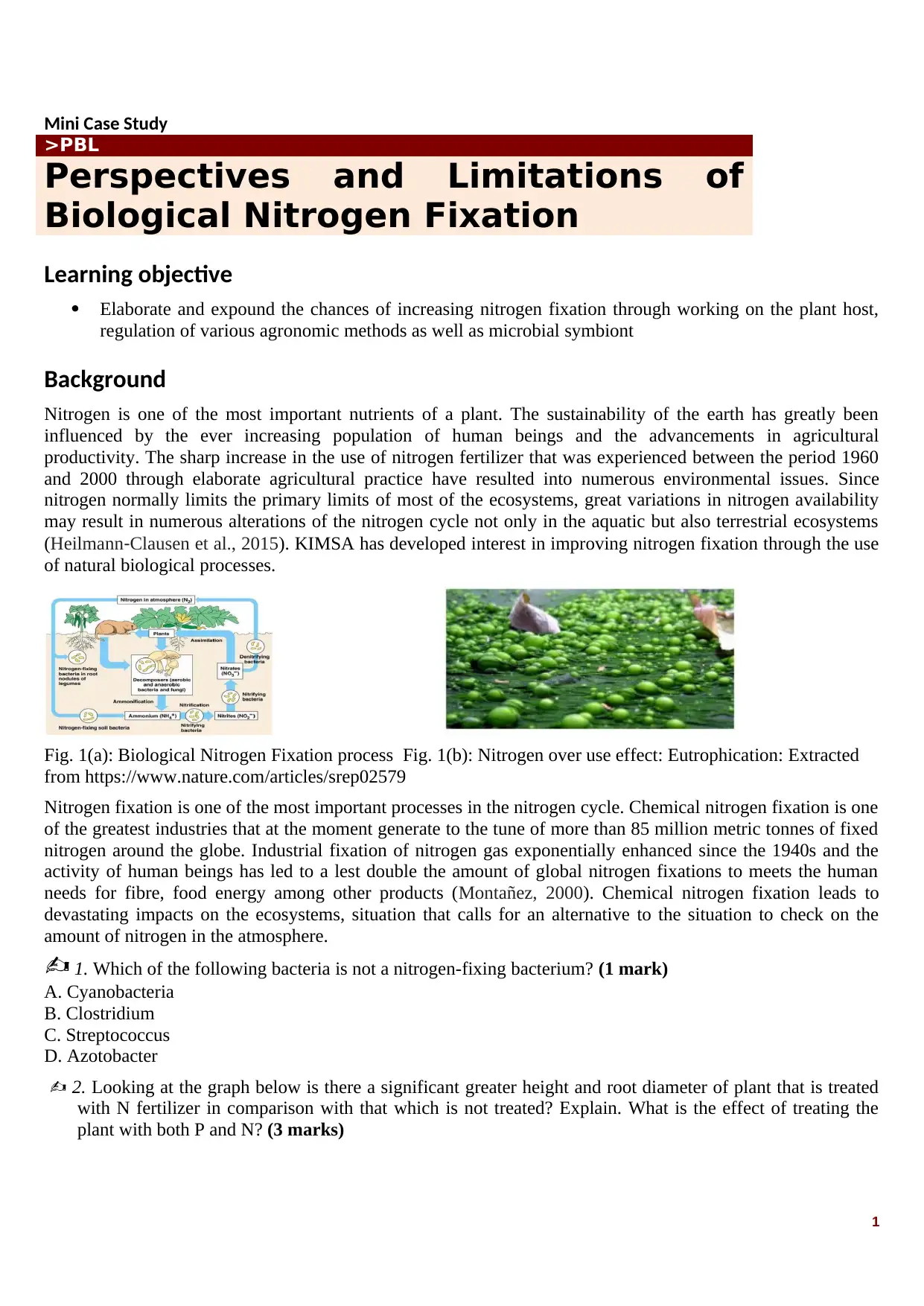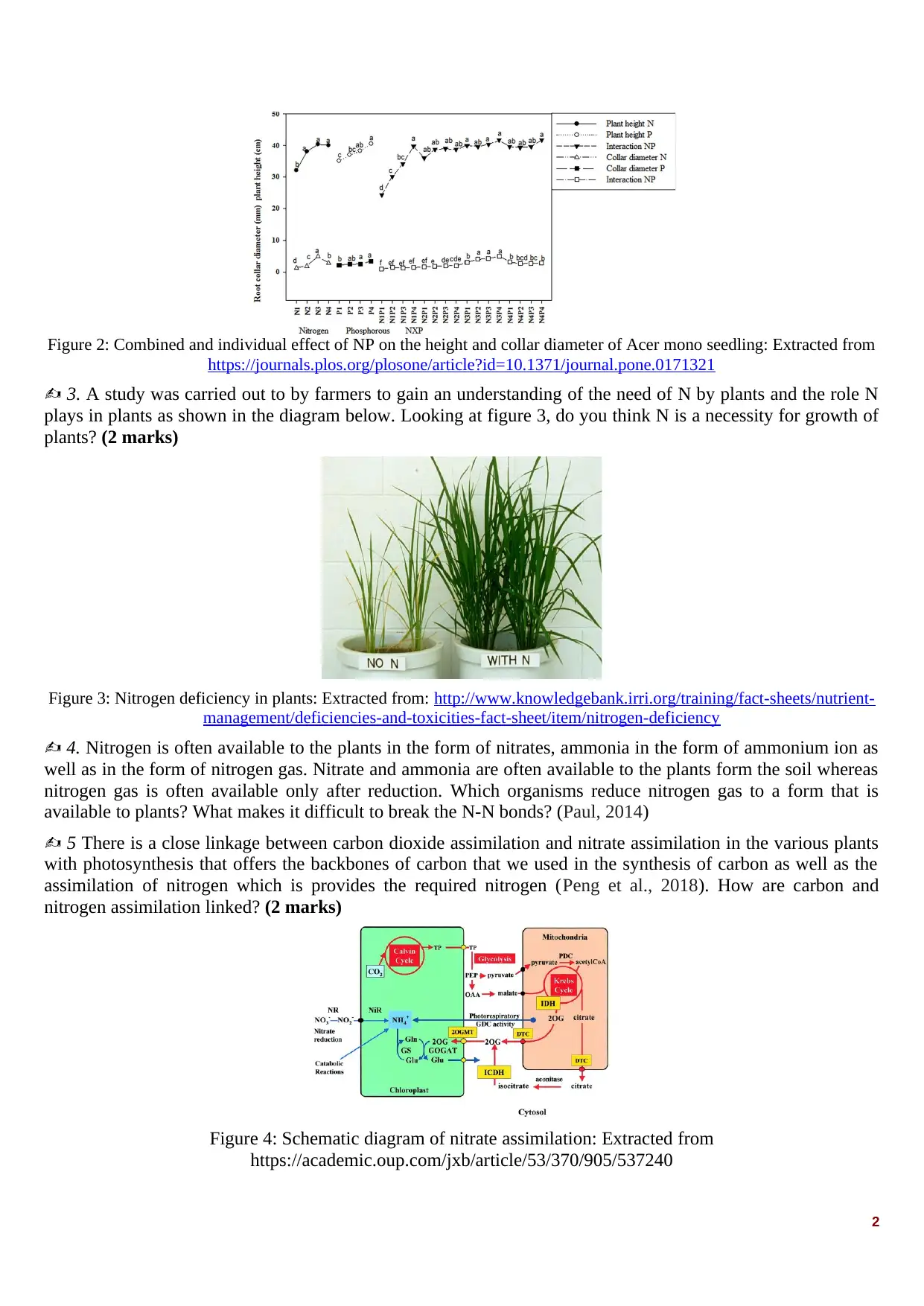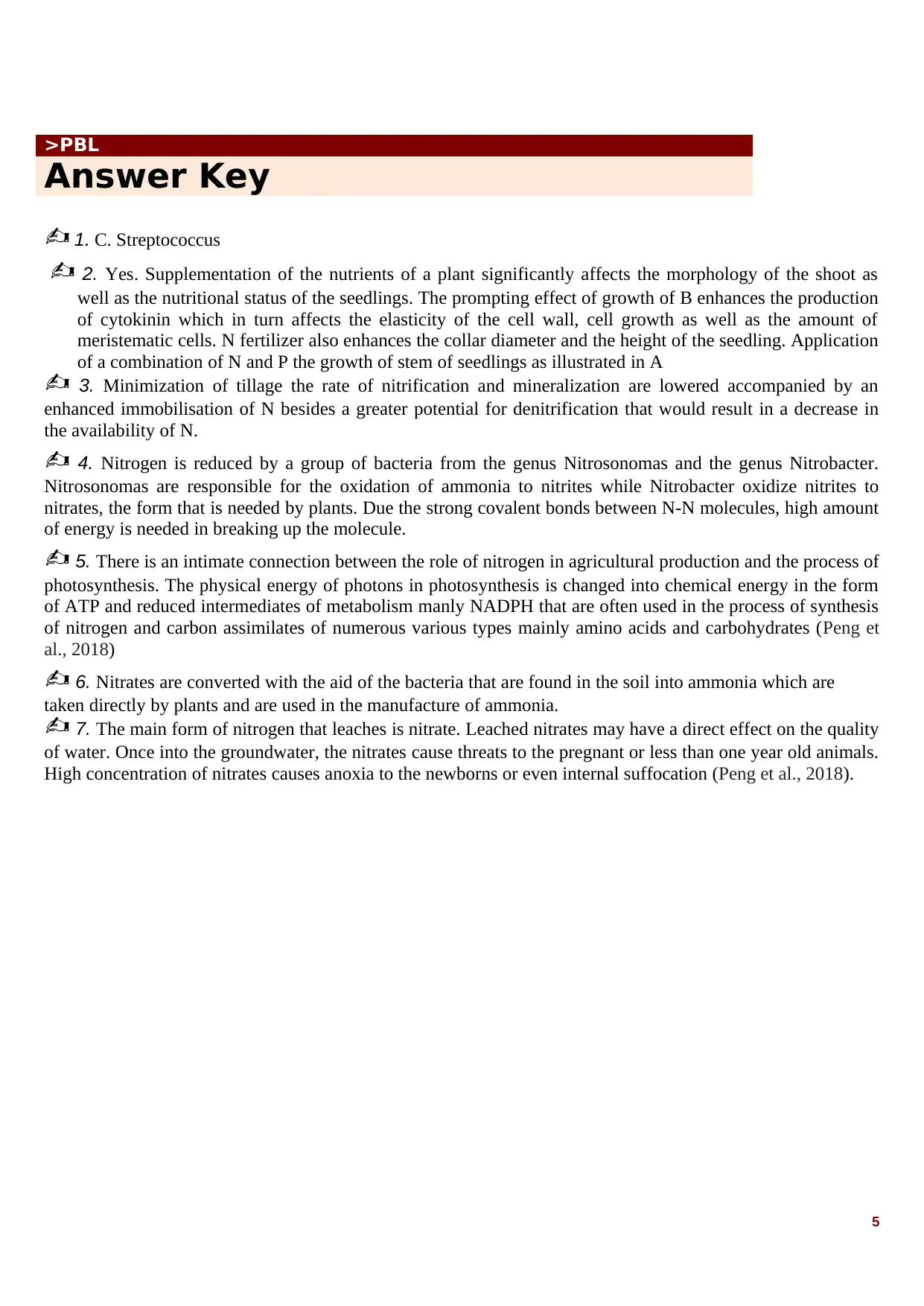Case Study: Biological Nitrogen Fixation - PBL Perspectives & Limits
VerifiedAdded on 2023/06/03
|5
|1421
|165
Case Study
AI Summary
This assignment presents a mini case study focused on biological nitrogen fixation, exploring its perspectives and limitations through a Problem-Based Learning (PBL) approach. It covers the importance of nitrogen for plant growth, the environmental issues associated with excessive nitrogen fertilizer use, and the potential for improving nitrogen fixation through natural biological processes. The case study includes questions addressing the role of nitrogen-fixing bacteria, the impact of nitrogen and phosphorus fertilizers on plant growth, the necessity of nitrogen for plant development, the process of nitrogen reduction by microorganisms, the linkage between carbon and nitrogen assimilation, the effect of tillage management on nitrogen fixation, and the environmental consequences of nitrogen leaching. The solution provides detailed answers to these questions, referencing scientific literature to support the explanations. The assignment aims to deepen understanding of nitrogen fixation and its ecological implications, offering a comprehensive analysis of the topic. Desklib provides access to similar solved assignments.

Mini Case Study
>PBL
Perspectives and Limitations of
Biological Nitrogen Fixation
Learning objective
Elaborate and expound the chances of increasing nitrogen fixation through working on the plant host,
regulation of various agronomic methods as well as microbial symbiont
Background
Nitrogen is one of the most important nutrients of a plant. The sustainability of the earth has greatly been
influenced by the ever increasing population of human beings and the advancements in agricultural
productivity. The sharp increase in the use of nitrogen fertilizer that was experienced between the period 1960
and 2000 through elaborate agricultural practice have resulted into numerous environmental issues. Since
nitrogen normally limits the primary limits of most of the ecosystems, great variations in nitrogen availability
may result in numerous alterations of the nitrogen cycle not only in the aquatic but also terrestrial ecosystems
(Heilmann‐Clausen et al., 2015). KIMSA has developed interest in improving nitrogen fixation through the use
of natural biological processes.
Fig. 1(a): Biological Nitrogen Fixation process Fig. 1(b): Nitrogen over use effect: Eutrophication: Extracted
from https://www.nature.com/articles/srep02579
Nitrogen fixation is one of the most important processes in the nitrogen cycle. Chemical nitrogen fixation is one
of the greatest industries that at the moment generate to the tune of more than 85 million metric tonnes of fixed
nitrogen around the globe. Industrial fixation of nitrogen gas exponentially enhanced since the 1940s and the
activity of human beings has led to a lest double the amount of global nitrogen fixations to meets the human
needs for fibre, food energy among other products (Montañez, 2000). Chemical nitrogen fixation leads to
devastating impacts on the ecosystems, situation that calls for an alternative to the situation to check on the
amount of nitrogen in the atmosphere.
1. Which of the following bacteria is not a nitrogen-fixing bacterium? (1 mark)
A. Cyanobacteria
B. Clostridium
C. Streptococcus
D. Azotobacter
2. Looking at the graph below is there a significant greater height and root diameter of plant that is treated
with N fertilizer in comparison with that which is not treated? Explain. What is the effect of treating the
plant with both P and N? (3 marks)
1
>PBL
Perspectives and Limitations of
Biological Nitrogen Fixation
Learning objective
Elaborate and expound the chances of increasing nitrogen fixation through working on the plant host,
regulation of various agronomic methods as well as microbial symbiont
Background
Nitrogen is one of the most important nutrients of a plant. The sustainability of the earth has greatly been
influenced by the ever increasing population of human beings and the advancements in agricultural
productivity. The sharp increase in the use of nitrogen fertilizer that was experienced between the period 1960
and 2000 through elaborate agricultural practice have resulted into numerous environmental issues. Since
nitrogen normally limits the primary limits of most of the ecosystems, great variations in nitrogen availability
may result in numerous alterations of the nitrogen cycle not only in the aquatic but also terrestrial ecosystems
(Heilmann‐Clausen et al., 2015). KIMSA has developed interest in improving nitrogen fixation through the use
of natural biological processes.
Fig. 1(a): Biological Nitrogen Fixation process Fig. 1(b): Nitrogen over use effect: Eutrophication: Extracted
from https://www.nature.com/articles/srep02579
Nitrogen fixation is one of the most important processes in the nitrogen cycle. Chemical nitrogen fixation is one
of the greatest industries that at the moment generate to the tune of more than 85 million metric tonnes of fixed
nitrogen around the globe. Industrial fixation of nitrogen gas exponentially enhanced since the 1940s and the
activity of human beings has led to a lest double the amount of global nitrogen fixations to meets the human
needs for fibre, food energy among other products (Montañez, 2000). Chemical nitrogen fixation leads to
devastating impacts on the ecosystems, situation that calls for an alternative to the situation to check on the
amount of nitrogen in the atmosphere.
1. Which of the following bacteria is not a nitrogen-fixing bacterium? (1 mark)
A. Cyanobacteria
B. Clostridium
C. Streptococcus
D. Azotobacter
2. Looking at the graph below is there a significant greater height and root diameter of plant that is treated
with N fertilizer in comparison with that which is not treated? Explain. What is the effect of treating the
plant with both P and N? (3 marks)
1
Paraphrase This Document
Need a fresh take? Get an instant paraphrase of this document with our AI Paraphraser

Figure 2: Combined and individual effect of NP on the height and collar diameter of Acer mono seedling: Extracted from
https://journals.plos.org/plosone/article?id=10.1371/journal.pone.0171321
3. A study was carried out to by farmers to gain an understanding of the need of N by plants and the role N
plays in plants as shown in the diagram below. Looking at figure 3, do you think N is a necessity for growth of
plants? (2 marks)
Figure 3: Nitrogen deficiency in plants: Extracted from: http://www.knowledgebank.irri.org/training/fact-sheets/nutrient-
management/deficiencies-and-toxicities-fact-sheet/item/nitrogen-deficiency
4. Nitrogen is often available to the plants in the form of nitrates, ammonia in the form of ammonium ion as
well as in the form of nitrogen gas. Nitrate and ammonia are often available to the plants form the soil whereas
nitrogen gas is often available only after reduction. Which organisms reduce nitrogen gas to a form that is
available to plants? What makes it difficult to break the N-N bonds? (Paul, 2014)
5 There is a close linkage between carbon dioxide assimilation and nitrate assimilation in the various plants
with photosynthesis that offers the backbones of carbon that we used in the synthesis of carbon as well as the
assimilation of nitrogen which is provides the required nitrogen (Peng et al., 2018). How are carbon and
nitrogen assimilation linked? (2 marks)
Figure 4: Schematic diagram of nitrate assimilation: Extracted from
https://academic.oup.com/jxb/article/53/370/905/537240
2
https://journals.plos.org/plosone/article?id=10.1371/journal.pone.0171321
3. A study was carried out to by farmers to gain an understanding of the need of N by plants and the role N
plays in plants as shown in the diagram below. Looking at figure 3, do you think N is a necessity for growth of
plants? (2 marks)
Figure 3: Nitrogen deficiency in plants: Extracted from: http://www.knowledgebank.irri.org/training/fact-sheets/nutrient-
management/deficiencies-and-toxicities-fact-sheet/item/nitrogen-deficiency
4. Nitrogen is often available to the plants in the form of nitrates, ammonia in the form of ammonium ion as
well as in the form of nitrogen gas. Nitrate and ammonia are often available to the plants form the soil whereas
nitrogen gas is often available only after reduction. Which organisms reduce nitrogen gas to a form that is
available to plants? What makes it difficult to break the N-N bonds? (Paul, 2014)
5 There is a close linkage between carbon dioxide assimilation and nitrate assimilation in the various plants
with photosynthesis that offers the backbones of carbon that we used in the synthesis of carbon as well as the
assimilation of nitrogen which is provides the required nitrogen (Peng et al., 2018). How are carbon and
nitrogen assimilation linked? (2 marks)
Figure 4: Schematic diagram of nitrate assimilation: Extracted from
https://academic.oup.com/jxb/article/53/370/905/537240
2

6 Looking at the table below for the influence of tillage management on biological nitrogen fixation, explain
the trend of the table and why. (1 mark)
Table 1: Effect of tillage practices on the fixation of nitrogen by legumes: Extracted from
http://www.fao.org/fileadmin/templates/agphome/scpi/SCPI_Compendium/
Overview_and_Case_studies_on_Biological_Nitrogen_Fixation.pdf
7. To ascertain an achievement of maximum yields from the plants, the farmers normally apply excess
nitrogen fertiliser which exceed the growth requirements which is turn result in large waste producing that is
environmentally and economically costly. What are the environmental issues associated with leaching of
nitrogen? (2 marks)
Figure 5: Effects of heavy rainfall on the nitrates: Extracted from https://extension2.missouri.edu/wq262
3
the trend of the table and why. (1 mark)
Table 1: Effect of tillage practices on the fixation of nitrogen by legumes: Extracted from
http://www.fao.org/fileadmin/templates/agphome/scpi/SCPI_Compendium/
Overview_and_Case_studies_on_Biological_Nitrogen_Fixation.pdf
7. To ascertain an achievement of maximum yields from the plants, the farmers normally apply excess
nitrogen fertiliser which exceed the growth requirements which is turn result in large waste producing that is
environmentally and economically costly. What are the environmental issues associated with leaching of
nitrogen? (2 marks)
Figure 5: Effects of heavy rainfall on the nitrates: Extracted from https://extension2.missouri.edu/wq262
3
⊘ This is a preview!⊘
Do you want full access?
Subscribe today to unlock all pages.

Trusted by 1+ million students worldwide

Sources
Heilmann‐Clausen, J., Barron, E. S., Boddy, L., Dahlberg, A., Griffith, G. W., Nordén, J., & Halme, P. (2015).
A fungal perspective on conservation biology. Conservation biology, 29(1), 61-68
Montañez, A. (2000). Overview and case studies on biological nitrogen fixation: Perspectives and
limitations. FAO, Case Study B, 2, 1-11
Montanez, A. (2011). Overview and case studies on biological nitrogen fixation: Perspectives and Limitations:
Work prepared for FAO
Mus, F., Crook, M. B., Garcia, K., Costas, A. G., Geddes, B. A., Kouri, E. D., ... & Udvardi, M. K. (2016).
Symbiotic nitrogen fixation and challenges to extending it to non-legumes. Applied and environmental
microbiology, AEM-01055
Paul, E. A. (2014). Soil microbiology, ecology and biochemistry. Academic press
Peng, J., Dan, L., Wang, Y. P., Tang, X., Yang, X., Yang, F., ... & Pak, B. (2018). Role contribution of
biological nitrogen fixation to future terrestrial net land carbon accumulation under warming condition
at centennial scale. Journal of Cleaner Production, 202, 1158-1166
4
Heilmann‐Clausen, J., Barron, E. S., Boddy, L., Dahlberg, A., Griffith, G. W., Nordén, J., & Halme, P. (2015).
A fungal perspective on conservation biology. Conservation biology, 29(1), 61-68
Montañez, A. (2000). Overview and case studies on biological nitrogen fixation: Perspectives and
limitations. FAO, Case Study B, 2, 1-11
Montanez, A. (2011). Overview and case studies on biological nitrogen fixation: Perspectives and Limitations:
Work prepared for FAO
Mus, F., Crook, M. B., Garcia, K., Costas, A. G., Geddes, B. A., Kouri, E. D., ... & Udvardi, M. K. (2016).
Symbiotic nitrogen fixation and challenges to extending it to non-legumes. Applied and environmental
microbiology, AEM-01055
Paul, E. A. (2014). Soil microbiology, ecology and biochemistry. Academic press
Peng, J., Dan, L., Wang, Y. P., Tang, X., Yang, X., Yang, F., ... & Pak, B. (2018). Role contribution of
biological nitrogen fixation to future terrestrial net land carbon accumulation under warming condition
at centennial scale. Journal of Cleaner Production, 202, 1158-1166
4
Paraphrase This Document
Need a fresh take? Get an instant paraphrase of this document with our AI Paraphraser

>PBL
Answer Key
1. C. Streptococcus
2. Yes. Supplementation of the nutrients of a plant significantly affects the morphology of the shoot as
well as the nutritional status of the seedlings. The prompting effect of growth of B enhances the production
of cytokinin which in turn affects the elasticity of the cell wall, cell growth as well as the amount of
meristematic cells. N fertilizer also enhances the collar diameter and the height of the seedling. Application
of a combination of N and P the growth of stem of seedlings as illustrated in A
3. Minimization of tillage the rate of nitrification and mineralization are lowered accompanied by an
enhanced immobilisation of N besides a greater potential for denitrification that would result in a decrease in
the availability of N.
4. Nitrogen is reduced by a group of bacteria from the genus Nitrosonomas and the genus Nitrobacter.
Nitrosonomas are responsible for the oxidation of ammonia to nitrites while Nitrobacter oxidize nitrites to
nitrates, the form that is needed by plants. Due the strong covalent bonds between N-N molecules, high amount
of energy is needed in breaking up the molecule.
5. There is an intimate connection between the role of nitrogen in agricultural production and the process of
photosynthesis. The physical energy of photons in photosynthesis is changed into chemical energy in the form
of ATP and reduced intermediates of metabolism manly NADPH that are often used in the process of synthesis
of nitrogen and carbon assimilates of numerous various types mainly amino acids and carbohydrates (Peng et
al., 2018)
6. Nitrates are converted with the aid of the bacteria that are found in the soil into ammonia which are
taken directly by plants and are used in the manufacture of ammonia.
7. The main form of nitrogen that leaches is nitrate. Leached nitrates may have a direct effect on the quality
of water. Once into the groundwater, the nitrates cause threats to the pregnant or less than one year old animals.
High concentration of nitrates causes anoxia to the newborns or even internal suffocation (Peng et al., 2018).
5
Answer Key
1. C. Streptococcus
2. Yes. Supplementation of the nutrients of a plant significantly affects the morphology of the shoot as
well as the nutritional status of the seedlings. The prompting effect of growth of B enhances the production
of cytokinin which in turn affects the elasticity of the cell wall, cell growth as well as the amount of
meristematic cells. N fertilizer also enhances the collar diameter and the height of the seedling. Application
of a combination of N and P the growth of stem of seedlings as illustrated in A
3. Minimization of tillage the rate of nitrification and mineralization are lowered accompanied by an
enhanced immobilisation of N besides a greater potential for denitrification that would result in a decrease in
the availability of N.
4. Nitrogen is reduced by a group of bacteria from the genus Nitrosonomas and the genus Nitrobacter.
Nitrosonomas are responsible for the oxidation of ammonia to nitrites while Nitrobacter oxidize nitrites to
nitrates, the form that is needed by plants. Due the strong covalent bonds between N-N molecules, high amount
of energy is needed in breaking up the molecule.
5. There is an intimate connection between the role of nitrogen in agricultural production and the process of
photosynthesis. The physical energy of photons in photosynthesis is changed into chemical energy in the form
of ATP and reduced intermediates of metabolism manly NADPH that are often used in the process of synthesis
of nitrogen and carbon assimilates of numerous various types mainly amino acids and carbohydrates (Peng et
al., 2018)
6. Nitrates are converted with the aid of the bacteria that are found in the soil into ammonia which are
taken directly by plants and are used in the manufacture of ammonia.
7. The main form of nitrogen that leaches is nitrate. Leached nitrates may have a direct effect on the quality
of water. Once into the groundwater, the nitrates cause threats to the pregnant or less than one year old animals.
High concentration of nitrates causes anoxia to the newborns or even internal suffocation (Peng et al., 2018).
5
1 out of 5
Your All-in-One AI-Powered Toolkit for Academic Success.
+13062052269
info@desklib.com
Available 24*7 on WhatsApp / Email
![[object Object]](/_next/static/media/star-bottom.7253800d.svg)
Unlock your academic potential
Copyright © 2020–2025 A2Z Services. All Rights Reserved. Developed and managed by ZUCOL.